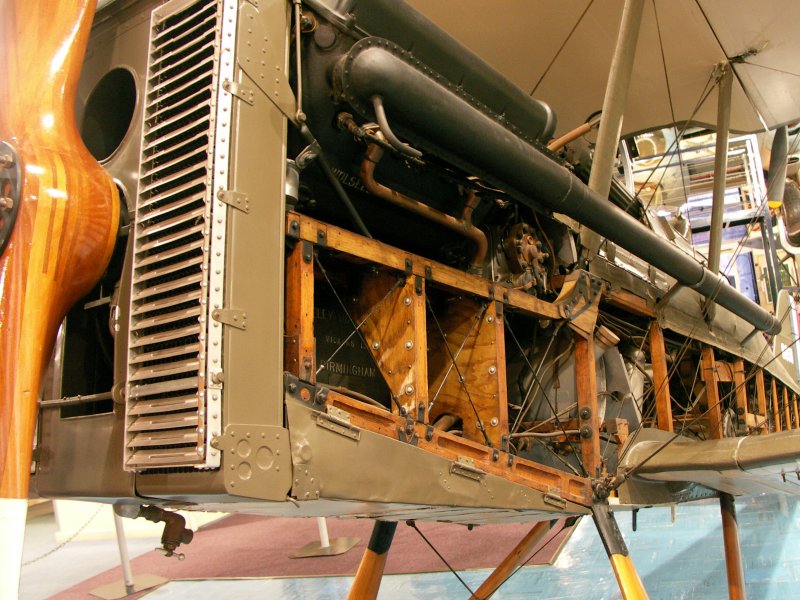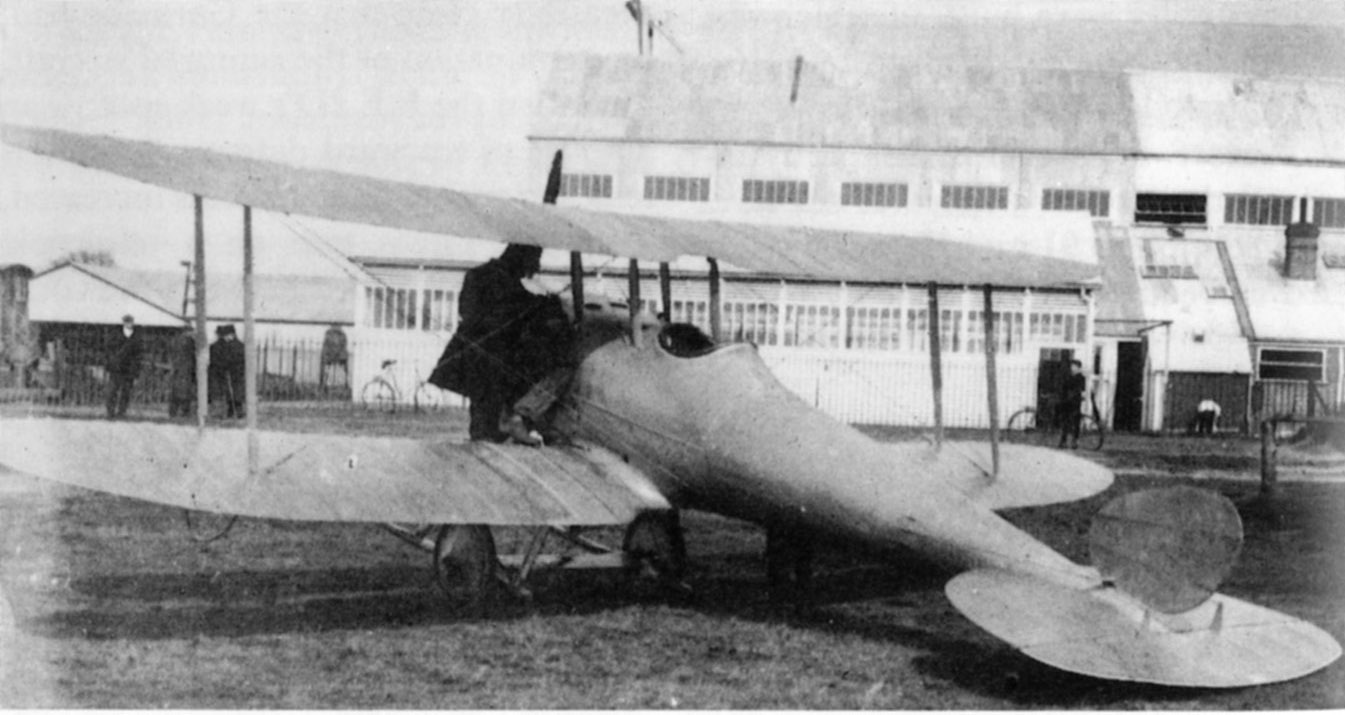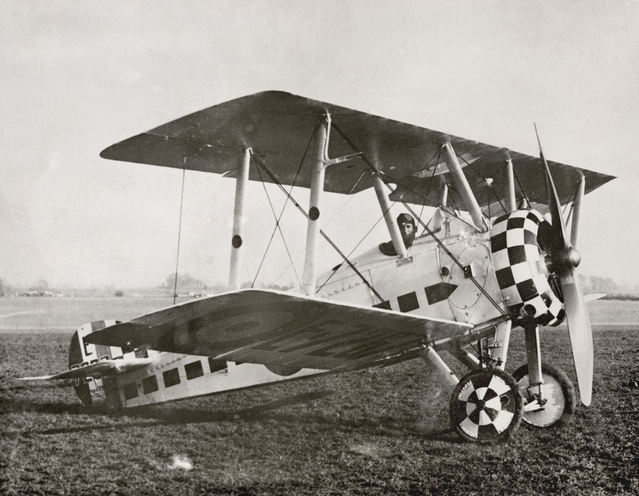|
S.E.5
The Royal Aircraft Factory S.E.5 is a British biplane fighter aircraft of the First World War. It was developed at the Royal Aircraft Factory by a team consisting of Henry Folland, John Kenworthy and Major Frank Goodden. It was one of the fastest aircraft of the war, while being both stable and relatively manoeuvrable. According to aviation author Robert Jackson, the S.E.5 was: "the nimble fighter that has since been described as the 'Spitfire of World War One'".Jackson 2007, p. 18. In most respects the S.E.5 had superior performance to the rival Sopwith Camel, although it was less immediately responsive to the controls. Problems with its Hispano-Suiza engine, particularly the geared-output H-S 8B-powered early versions, meant that there was a chronic shortage of the type until well into 1918. Thus, while the first examples had reached the Western Front before the Camel, there were fewer squadrons equipped with the S.E.5 than with the Sopwith fighter. Together with the ... [...More Info...] [...Related Items...] OR: [Wikipedia] [Google] [Baidu] |
Hispano-Suiza 8
The Hispano-Suiza 8 is a Internal combustion engine cooling, water-cooled V8 engine, V8 SOHC aero engine introduced by Hispano-Suiza in 1914 that went on to become the most commonly used liquid-cooled engine in the aircraft of the Entente Powers during the First World War. The original Hispano-Suiza 8A was rated at and the later, larger displacement Hispano-Suiza 8F reached . Hispano-Suiza 8 engines and variants produced by Hispano-Suiza and other companies under licence were built in twenty-one factories in Spain, France, Britain, Italy, and the U.S. Derivatives of the engine were also used abroad to power numerous aircraft types and the engine can be considered as the ancestor of another successful engine by the same designer, the Hispano-Suiza 12Y (and Soviet Klimov V12 derivative aero-engines) which was in service during the Second World War. Design and development Origins At the beginning of World War I, the production lines of the Barcelona based Hispano-Suiza automobil ... [...More Info...] [...Related Items...] OR: [Wikipedia] [Google] [Baidu] |
Frank Goodden
Major Frank Widenham Goodden (3 October 1889 – 28 January 1917) was a pioneering British aviator who served as chief test pilot for the Royal Aircraft Factory during the First World War. Early life and pre-war flying career Goodden was born in Pembroke, the second son of Harry Francis Goodden, a photographer from Eastbourne, and his wife, Emma Margaret Gould. He left school aged 16 and worked in engineering for three years before joining the balloon manufacturing company C. G. Spencer and Sons in 1908. The following year he made his first balloon flight, before giving exhibition flights in towns across Britain. Goodden left Spencers in October 1910 to be the engineer for Ernest Willows in his Airship No. 3 "City of Cardiff" on a flight between London and Paris. The airship took off from Wormwood Scrubbs mid-afternoon on 4 November, taking three hours to reach the English coast and another two to cross the Channel. After night fell, cloud and fog meant they became lost over F ... [...More Info...] [...Related Items...] OR: [Wikipedia] [Google] [Baidu] |
Royal Aircraft Establishment
The Royal Aircraft Establishment (RAE) was a British research establishment, known by several different names during its history, that eventually came under the aegis of the Ministry of Defence (United Kingdom), UK Ministry of Defence (MoD), before finally losing its identity in mergers with other institutions. The British Army Balloon Factory was established on Farnborough Common in the early 1900s. By 1912 it had come under civilian control and was the Royal Aircraft Factory (RAF) In 1918 it was renamed Royal Aircraft Establishment to prevent confusion with the newly created Royal Air Force. The first site was at Farnborough Airfield ("RAE Farnborough") in Hampshire to which was added a second site RAE Bedford (Bedfordshire) in 1946. On 1 May 1988 it was renamed the Royal Aerospace Establishment (RAE) before merging with other research entities to become part of the new Defence Research Agency in 1991. History In 1904–1906 the Army Balloon Factory, which was part of the A ... [...More Info...] [...Related Items...] OR: [Wikipedia] [Google] [Baidu] |
Sopwith Camel
The Sopwith Camel is a British First World War single-seat biplane fighter aircraft that was introduced on the Western Front in 1917. It was developed by the Sopwith Aviation Company as a successor to the Sopwith Pup and became one of the best-known fighter aircraft of the Great War. Pilots flying Camels were credited with downing 1,294 enemy aircraft, more than any other Allied fighter of the conflict. Towards the end of the war, Camels lost their edge as fighters and were also used as a ground-attack aircraft. The Camel was powered by a single rotary engine and was armed with twin synchronized Vickers machine guns. It was difficult to fly, with 90% of its weight in the front two metres (seven feet) of the aircraft, but it was highly manoeuvrable in the hands of an experienced pilot, a vital attribute in the relatively low-speed, low-altitude dogfights of the era. Its pilots joked that their fates would involve "a wooden cross, the Red Cross, or a Victoria Cross". T ... [...More Info...] [...Related Items...] OR: [Wikipedia] [Google] [Baidu] |
Henry Folland
Henry Philip Folland OBE (22 January 1889 – 5 September 1954) was an English aviation engineer and aircraft designer. Early years Folland was born on 22 January 1889 to Frederick and Mary Folland at 2 King Street, Holy Trinity, Cambridge.1891 Cambridge Census RG12/1287, Folio 64, p. 5. His father was listed as a Stonemason. Aviation career In 1905, Folland became an apprentice at the Lanchester Motor Company in Birmingham, he then joined the design staff at Swift Motor Company and then in 1908 he became a draughtsman at the Daimler Company. It was at Daimler that he developed his interest in powered flying machines. Folland worked at the Royal Aircraft Factory at Farnborough from 1912,''Flight'' 10 September 1954, p. 395. where he was lead designer on the S.E.4 and later S.E.5. The S.E.4 was the fastest aircraft known in 1914, and the S.E.5 was a major fighter aircraft during the First World War. He also designed the Royal Aircraft Factory's "Aerial Target" (built by Ru ... [...More Info...] [...Related Items...] OR: [Wikipedia] [Google] [Baidu] |
Royal Flying Corps
The Royal Flying Corps (RFC) was the air arm of the British Army before and during the First World War until it merged with the Royal Naval Air Service on 1 April 1918 to form the Royal Air Force. During the early part of the war, the RFC supported the British Army by artillery co-operation and photographic reconnaissance. This work gradually led RFC pilots into aerial battles with German pilots and later in the war included the strafing of enemy infantry and emplacements, the bombing of German military airfields and later the strategic bombing of German industrial and transport facilities. At the start of World War I the RFC, commanded by Brigadier-General Sir David Henderson, consisted of five squadrons – one observation balloon squadron (RFC No 1 Squadron) and four aeroplane squadrons. These were first used for aerial spotting on 13 September 1914 but only became efficient when they perfected the use of wireless communication at Aubers Ridge on 9 May 1915. Ae ... [...More Info...] [...Related Items...] OR: [Wikipedia] [Google] [Baidu] |
Bloody April
Bloody April was the (largely successful) British air support operation during the Battle of Arras (1917), Battle of Arras in April 1917, during which particularly heavy casualties were suffered by the Royal Flying Corps at the hands of the German ''Luftstreitkräfte''. The tactical, technological, and training differences between the two sides ensured the British suffered a casualty rate nearly four times as great as their opponents. The losses were so disastrous that it threatened to undermine the morale of entire Squadron (aviation), squadrons. The RFC contributed to the success, limited as it finally proved, of the British Army during the five-week series of battles. Background In April 1917 the British Army began an offensive at Arras, planned in conjunction with the French High Command, who were simultaneously embarking on a massive attack (the ''Nivelle Offensive'') about to the south. The Royal Flying Corps (RFC) supported British operations by offering close air suppor ... [...More Info...] [...Related Items...] OR: [Wikipedia] [Google] [Baidu] |
John Kenworthy
John Kenworthy B.Sc., F.R.Aes (1883–1940) was an English aviation engineer and aircraft designer. John Kenworthy appears in the 1901 Census of Darlington, aged 17, living with four sisters, one brother and his parents George and Ellen Kenworthy at 65 Greenbank Road, Darlington, County Durham. His father was listed as a Schoolmaster. In his early years he was a design assistant at the Royal Aircraft Factory formed out of the HM Balloon factory in 1911 at Farnborough, Hampshire. His first design in 1912 was the B.E.3 (Blériot Experimental), also known as the Goldfish because of its horizontal tail fin. He also designed the H.R.E.2 (Hydro Reconnaissance Experimental), a floatplane version of the earlier B.E.2 designed by Geoffrey de Havilland. Following closely in 1912 was the ( B.E.4, B.E.7 and in 1913 the B.E.8) After the outbreak of the First World War in 1914, the Royal Flying Corps (RFC) needed fighter and reconnaissance aircraft from the Royal Aircraft Factory and Ken ... [...More Info...] [...Related Items...] OR: [Wikipedia] [Google] [Baidu] |
United States Army Air Service
The United States Army Air Service (USAAS)Craven and Cate Vol. 1, p. 9 (also known as the ''"Air Service"'', ''"U.S. Air Service"'' and before its legislative establishment in 1920, the ''"Air Service, United States Army"'') was the aerial warfare service component of the United States Army between 1918 and 1926 and a forerunner of the United States Air Force. It was established as an independent but temporary branch of the United States Department of War, U.S. War Department during World War I by two executive orders of President Woodrow Wilson: on May 24, 1918, replacing the Aviation Section, U.S. Signal Corps, Aviation Section, Signal Corps as the nation's air force; and March 19, 1919, establishing a military Director of Air Service to control all aviation activities., p. 149, Appendix 2 Redesignations of the Army Air Arm, 1907–1942. Its life was extended for another year in July 1919, during which time Congress passed the legislation necessary to make it a permanent establ ... [...More Info...] [...Related Items...] OR: [Wikipedia] [Google] [Baidu] |
Farnborough, Hampshire
Farnborough is a town located in the Rushmoor district of Hampshire, England. It has a population of around 57,486 as of the 2011 census and is an important centre of aviation, engineering and technology. The town is probably best known for its association with aviation, including Samuel Cody, Farnborough Airport, the Farnborough International Airshow, Royal Aircraft Establishment and the Air Accidents Investigation Branch. History Pre-history and early settlements The earliest evidence of human settlement around Farnborough dates back thousands of years. Archaeologists have uncovered flint tools and other artefacts from the Mesolithic period, indicating the presence of hunter-gatherer communities in the area over 8,000 years ago. During the Neolithic period, the region saw increasing agricultural activity and the development of more permanent settlements. Excavations have revealed the remains of several prehistoric enclosures and barrows within the boundaries of modern-day Far ... [...More Info...] [...Related Items...] OR: [Wikipedia] [Google] [Baidu] |
Sopwith Aviation Company
The Sopwith Aviation Company was a British aircraft company that designed and manufactured aeroplanes mainly for the British Royal Naval Air Service, the Royal Flying Corps and later the Royal Air Force during the First World War, most famously the Sopwith Camel. Sopwith aircraft were also used in varying numbers by the French, Belgian and American air services during the war. In April 1919, the company was renamed as the Sopwith Aviation & Engineering Company Limited. In September 1920, the company entered voluntary liquidation after an attempt to build motorcycles failed. The patents and other assets were bought by a new company, H.G. Hawker Engineering. Early years The Sopwith Aviation Company (based at Brooklands) was created in June 1912 by Thomas Sopwith, a wealthy sportsman interested in aviation, yachting and motor-racing, when he was 24 years old. Following their first military aircraft sale in November 1912, Sopwith moved to the company's first factory premises whic ... [...More Info...] [...Related Items...] OR: [Wikipedia] [Google] [Baidu] |
Royal Aircraft Factory SE5a
Royal may refer to: People * Royal (name), a list of people with either the surname or given name * A member of a royal family or royalty Places United States * Royal, Arkansas, an unincorporated community * Royal, Illinois, a village * Royal, Iowa, a city * Royal, Missouri, an unincorporated community * Royal, Nebraska, a village * Royal, Franklin County, North Carolina, an unincorporated area * Royal, Utah, a ghost town * Royal, West Virginia, an unincorporated community * Royal Gorge, on the Arkansas River in Colorado * Royal Township (other) Elsewhere * Mount Royal, a hill in Montreal, Canada * Royal Canal, Dublin, Ireland * Royal National Park, New South Wales, Australia Arts, entertainment, and media * ''Royal'' (Jesse Royal album), 2021 * Royal (Ayo album), 2020 * '' The Royal'', a British medical drama television series * '' The Royal Magazine'', a monthly British literary magazine published between 1898 and 1939 * '' The Raja Saab'', working ti ... [...More Info...] [...Related Items...] OR: [Wikipedia] [Google] [Baidu] |






